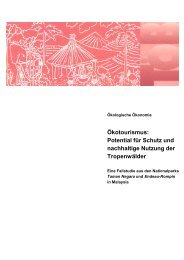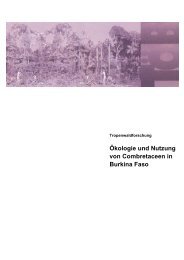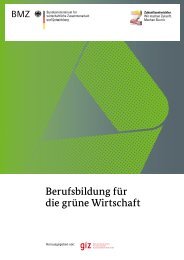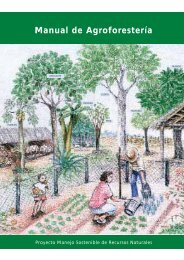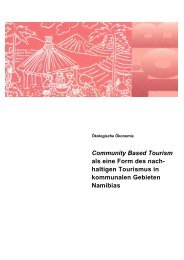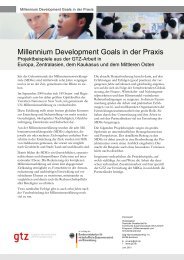2. GLOBAL NEEM DISSEMINATION AND USAGE2. <strong>Global</strong> <strong>Neem</strong> Disseminati<strong>on</strong> and <strong>Usage</strong>2.1 Geographical Distributi<strong>on</strong> and Types of <strong>Usage</strong>The neem tree, also known as the "Indian neem tree" (Azadirachta indica) is native to SouthAsia, whereby the South of India and Myanmar are the main areas of origin (2, 13, 15, 19). Inthe course of this century, however, the neem tree has spread globally al<strong>on</strong>g the tropical belt(see world map, page 10).The tree is most widespread in India - from the most southerly regi<strong>on</strong> around Kerala up to theHimalayas. Estimates currently run at approx. 14 to 20 milli<strong>on</strong> neem trees throughout thecountry, with roughly 10 milli<strong>on</strong> trees in the two provinces of Uttar Pradesh and Tamil Nadual<strong>on</strong>e (2, 13, 15, 19, 23).All of today’s uses of neem can be traced back to traditi<strong>on</strong>al forms of usage in India. Nowadays,uses range from simple and extensive to modern and intensive. Smallholders and therural populati<strong>on</strong> collect neem raw materials which they then use for medicine, stock protecti<strong>on</strong>,etc. Numerous small to medium-sized companies in India manufacture commercialneem products of varying quality which are marketed almost exclusively <strong>on</strong> a domestic scale.The seeds are the most important raw material for exploiting neem. They are collected by therural populati<strong>on</strong> and are then mainly sold <strong>on</strong> markets or to dealers. The seeds are chieflypressed to obtain oil for soap producti<strong>on</strong>. The press cakes thus produced are in turn theparent material for manufacturing formulated pesticides. The wood, bark and leaves have<strong>on</strong>ly a limited market value and are predominately used by the rural populati<strong>on</strong>.In Myanmar the neem tree is particularly well established in the central regi<strong>on</strong>s of Mandalay,Magwe and Sagaing. Only a few ten thousand neem trees are to be found in the lower partof Nepal (Terai), whereas in Bangladesh and Pakistan, the neem is a typical and comm<strong>on</strong>sight. What is more, it has been found in Sri Lanka's northerly, mid-easterly and southeasterlysemi-arid areas in numbers of more than 1 milli<strong>on</strong> stems (4, 19, 23, 26, 28).Knowledge of neem's many possible uses is not as widespread in these countries as inneighbouring India. But nevertheless, neem is still an important natural resource here too.In the People's Republic of China the first hundreds of neem trees were planted in the early1980s <strong>on</strong> the peninsula of Hainan and the southern part of Guangd<strong>on</strong>g and are now thriving.In the mid-1990s larger-scale reafforestati<strong>on</strong> with some 100 000 neem trees took place inHainan and the southern valleys of Kumming province (27).In Southeast Asia the neem tree is mostly found in the hot, lowland areas with marked dryperiods. In Thailand the neem species encountered most frequently throughout the country iscalled "Thai neem" (Azadirachta siamensis) which makes up 2/3 of all the neem trees there.Viet Nam planted its first neem trees a few years ago. However, the trees are not growingand fruiting well in the northern provinces due to the cold temperature and in the southernregi<strong>on</strong> due to the typho<strong>on</strong>s. In Ind<strong>on</strong>esia neem can be found in the eastern and more7
2. GLOBAL NEEM DISSEMINATION AND USAGEnortherly, lower-lying regi<strong>on</strong>s of Java, although neem is also endemic to the eastern, drierislands such as the northern part of Bali, Lombok etc. in several hundred thousand stems.Several thousand neem trees can been found in the low-lying areas of Papua New Guinea,mainly near the capital Port Moresby and a few in the Markam valley and <strong>on</strong> East NewBritain and other smaller islands of the Bismarck Archipelago. Here the tree is, however, <strong>on</strong>lyexploited <strong>on</strong> a very small scale, as is the case <strong>on</strong> a few other Pacific Islands <strong>on</strong> which it isfound (19).In Fiji several ten thousand fruiting neem trees exist in the drier western parts of Veti Levuand there have been activities there to set up neem plantati<strong>on</strong>s.<strong>Neem</strong> has also been introduced <strong>on</strong> a number of larger islands such as Cebu, Negros etc. inthe Philippines. However the trees are not growing well due to frequent typho<strong>on</strong>s.With the excepti<strong>on</strong> of Thailand, knowledge about the various uses of neem is not very widespreadin these countries (4, 19, 23).In Queensland in the north-east of Australia, no less than half a milli<strong>on</strong> neem trees havebeen planted in recent years. Besides reafforestati<strong>on</strong> and erosi<strong>on</strong> protecti<strong>on</strong>, the Australianshave set great hopes <strong>on</strong> the use of neem as a n<strong>on</strong>-synthetic pesticide (6, 19).In Western Asia neem is found in the southern, low-lying regi<strong>on</strong>s of Iran and in theEuphrates-Tigris valley in Iraq. <strong>Neem</strong> trees have also been planted <strong>on</strong> the ArabianPeninsula, mostly as shade trees. Indeed, large numbers have been planted near Mecca inSaudi Arabia (19).The tree most likely made its way to Africa as a result of British col<strong>on</strong>ialism at the start of thiscentury al<strong>on</strong>g with servants and immigrants from India. Today neem is found in c<strong>on</strong>siderablenumbers al<strong>on</strong>g the east coast from Eritrea (an estimated 500 000 trees, 46) and Somalia viaKenya (several milli<strong>on</strong> trees) and Tanzania northwards to Mozambique. It is very widespread– with several hundred thousand trees - in the dry, south-westerly and western regi<strong>on</strong>s ofMadagascar (39) and is found throughout the island of Mauritius. Many neem trees are alsoto be found in some central regi<strong>on</strong>s of East Africa, e.g. in Uganda (25 000), Kenya, Tanzaniaand Malawi (350 000 stems) (19, 21, 29).<strong>Neem</strong> is frequently encountered in sub-Saharan Africa: many milli<strong>on</strong>s of neem trees arelocated through the entire area from Ethiopia with roughly 30 000 trees growing in the lowerparts and Sudan (several milli<strong>on</strong>), to Senegal (6 milli<strong>on</strong>) and Mauritania (approx. 100 000).The climatic c<strong>on</strong>diti<strong>on</strong>s are particularly favourable here between the 10th and the 15thnorthern parallels where the climate is hot with a precipitati<strong>on</strong> level of between 500 and 1200mm/a falling in a rainy seas<strong>on</strong> lasting a few m<strong>on</strong>ths. <strong>Neem</strong>'s northerly expansi<strong>on</strong> is cappedby the decreasing levels of rainfall. This is why, north of the 15th parallel, neem is <strong>on</strong>ly everfound al<strong>on</strong>g stretches of water or in villages, where it can be watered. <strong>Neem</strong> occurs frequentlyin Senegal, Ghana (approx. 6 milli<strong>on</strong>), Nigeria (some 10 milli<strong>on</strong>), Mali, Burkina Fasoand Niger (2.5 milli<strong>on</strong>) (1, 14, 19, 21).8
- Page 2 and 3: iviDivision 45Rural DevelopmentWork
- Page 4 and 5: Table of ContentsPageForeword for t
- Page 6 and 7: FOREWORDForeword for the 2 nd Editi
- Page 8 and 9: SUMMARYIndeed, neem has been effect
- Page 12 and 13: 2. GLOBAL NEEM DISSEMINATION AND US
- Page 14 and 15: 2. GLOBAL NEEM DISSEMINATION AND US
- Page 16 and 17: 2. GLOBAL NEEM DISSEMINATION AND US
- Page 18 and 19: 2. GLOBAL NEEM DISSEMINATION AND US
- Page 20 and 21: 2. GLOBAL NEEM DISSEMINATION AND US
- Page 22 and 23: 2. GLOBAL NEEM DISSEMINATION AND US
- Page 24 and 25: 2. GLOBAL NEEM DISSEMINATION AND US
- Page 26 and 27: 3. NEEM AS A NON-SYNTHETIC PESTICID
- Page 28 and 29: 3. NEEM AS A NON-SYNTHETIC PESTICID
- Page 30 and 31: 3. NEEM AS A NON-SYNTHETIC PESTICID
- Page 32 and 33: 3. NEEM AS A NON-SYNTHETIC PESTICID
- Page 34 and 35: 3. NEEM AS A NON-SYNTHETIC PESTICID
- Page 36 and 37: 3. NEEM AS A NON-SYNTHETIC PESTICID
- Page 38 and 39: 3. NEEM AS A NON-SYNTHETIC PESTICID
- Page 40 and 41: 3. NEEM AS A NON-SYNTHETIC PESTICID
- Page 42 and 43: 3. NEEM AS A NON-SYNTHETIC PESTICID
- Page 44 and 45: 3. NEEM AS A NON-SYNTHETIC PESTICID
- Page 46 and 47: 3. NEEM AS A NON-SYNTHETIC PESTICID
- Page 48 and 49: 4. NEEM IN DEVELOPMENT-COOPERATION
- Page 50 and 51: 4. NEEM IN DEVELOPMENT-COOPERATION
- Page 52 and 53: 4. NEEM IN DEVELOPMENT-COOPERATION
- Page 54 and 55: 4. NEEM IN DEVELOPMENT-COOPERATION
- Page 56 and 57: 4. NEEM IN DEVELOPMENT-COOPERATION
- Page 58 and 59: 4. NEEM IN DEVELOPMENT-COOPERATION
- Page 60 and 61:
4. NEEM IN DEVELOPMENT-COOPERATION
- Page 62 and 63:
4. NEEM IN DEVELOPMENT-COOPERATION
- Page 64 and 65:
4. NEEM IN DEVELOPMENT-COOPERATION
- Page 66 and 67:
4. NEEM IN DEVELOPMENT-COOPERATION
- Page 68 and 69:
4. NEEM IN DEVELOPMENT-COOPERATION
- Page 70 and 71:
4. NEEM IN DEVELOPMENT-COOPERATION
- Page 72 and 73:
4. NEEM IN DEVELOPMENT-COOPERATION
- Page 74 and 75:
4. NEEM IN DEVELOPMENT-COOPERATION
- Page 76 and 77:
4. NEEM IN DEVELOPMENT-COOPERATION
- Page 78 and 79:
4. NEEM IN DEVELOPMENT-COOPERATION
- Page 80 and 81:
4. NEEM IN DEVELOPMENT-COOPERATION
- Page 82 and 83:
4. NEEM IN DEVELOPMENT-COOPERATION
- Page 84 and 85:
4. NEEM IN DEVELOPMENT-COOPERATION
- Page 86 and 87:
4. NEEM IN DEVELOPMENT-COOPERATION
- Page 88 and 89:
4. NEEM IN DEVELOPMENT-COOPERATION
- Page 90 and 91:
4. NEEM IN DEVELOPMENT-COOPERATION
- Page 92 and 93:
4. NEEM IN DEVELOPMENT-COOPERATION
- Page 94 and 95:
4. NEEM IN DEVELOPMENT-COOPERATION
- Page 96 and 97:
4. NEEM IN DEVELOPMENT-COOPERATION
- Page 98 and 99:
4. NEEM IN DEVELOPMENT-COOPERATION
- Page 100 and 101:
4. NEEM IN DEVELOPMENT-COOPERATION
- Page 102 and 103:
5. PROSPECTS AND POSSIBILITIES FOR
- Page 104 and 105:
6. OUTLOOK6. OutlookIn many develop
- Page 106 and 107:
ANNEXAnnex103
- Page 108 and 109:
ANNEX14 OSTERMANN, H.: Zur Wirtscha
- Page 110 and 111:
ANNEX41 GRUNEWALD, J. & A. VOLLMER
- Page 112 and 113:
ANNEXGERRITS, R., VAN LATUM, E., (1
- Page 114 and 115:
ANNEXList of addresses of those org
- Page 116 and 117:
ANNEX- Coopération de Soyo, Martin
- Page 118 and 119:
ANNEXList of Publications on Neem o
- Page 120 and 121:
ANNEXHELLPAP, C. & DREYER, M. (1995
- Page 122 and 123:
ANNEXInternational Institute of Tro
- Page 124 and 125:
ANNEXSOMBATSIRI, K., ERMEL, K. & SC



